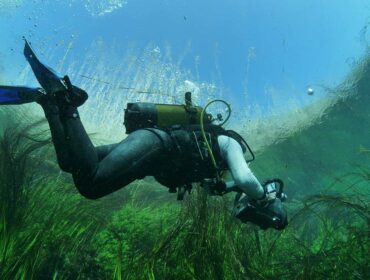Jellyfish stings can be very painful and the chances of getting stung by these difficult to see creatures are rather high in certain areas. Unfortunately very few people know how to treat jellyfish stings which can cause a lot of unnecessary distress. Knowing how to treat jellyfish stings will save you a lot pain and agony when you’re out snorkeling, scuba diving or swimming in the ocean.
The best step to avoid getting stung in the first place is through prevention. When scuba diving, surfing or snorkeling in known jellyfish infested waters, try and make use of protective gear, such as, full length wetsuits, gloves, booties etc. are a great way to protect your skin from the stinging tentacles of a jellyfish. Always stay vigilant when in the water as translucent jellyfish are often difficult to spot, and often get divers when they are ascending or doing a surface swim.
If you do get stung by a jellyfish here is what you need to do:
Get Out of the Water Immediately
As soon as you realize you’ve been stung by a jellyfish, and believe me you’ll know, it is important to get out of the water. Not just to treat the sting, but because the sting may cause an Anaphylactic shock or the victim to pass out due to the pain, and the last place you want to be is in the water should these occur.
Remove the Tentacles From the Skin
Remove the stinging tentacles from the skin immediately as the jellyfishes tentacles contain the toxic nematocysts that cause the pain. Remember to wear gloves when removing the tentacles, or use a stick, tweezers, sand, a beach towel or even a credit card to scrape off the tentacles from the skin.
Relieve Jellyfish Stings with Vinegar, Hot Water or a commercially available jellyfish relief solution.
Rinse the tentacles off. Rinse away the tentacles using hot water if possible. Do not wash the affected area with fresh water as it may worsen the stinging pain by reducing the osmotic pressure of the stinging cells drawing out more toxin. Fresh water however heated to above 122F or 50C is proven to be highly effective in rinsing away the stinging cells to inactivate the toxin in the venom. Vinegar or acetic acid works great on jellyfish stings as the mild acid breaks down the protein toxins of the jellyfish venom providing instant relief. Urinating on the sting usually does not work and is not recommended. Always keep a bottle of ordinary kitchen vinegar at hand when visiting the beach or going scuba diving , however applying one of the below mentioned commercially available jellyfish sting relief formulas works great as well, and if you frequent waters where jellyfish are known to visit, then we highly recommend you purchase some.
Wipe-Away Pain for Jellyfish Sting available at Scuba.com
Watch for anaphylaxis or allergic reactions
In most cases the victim should be fine if treated with the above mentioned first aid steps, however there is always the chance that the victim develops a severe allergic reaction or Anaphylaxis. Observe the victim carefully for signs of symptoms and always seek emergency medical treatment for these:
- itching
- hives
- shortness of breath
- wheezing
- tightening of the throat
- flushed skin
- weakness
- dizziness
Perform the above basic first aid and Seek emergency medical attention if the sting is caused by the box jellyfish, irukandji or The Portuguese or Pacific man-of-war or the bluebottle as these stings can be very severe and will require immediate medical attention to treat.
photos from flickr by: pete&brook, rexb, hodgers









